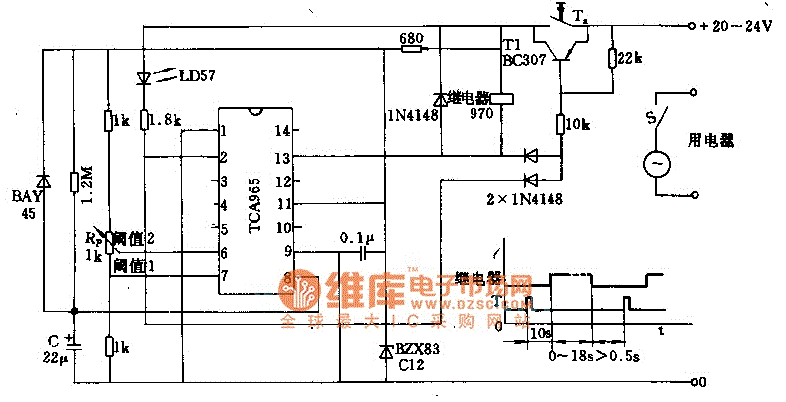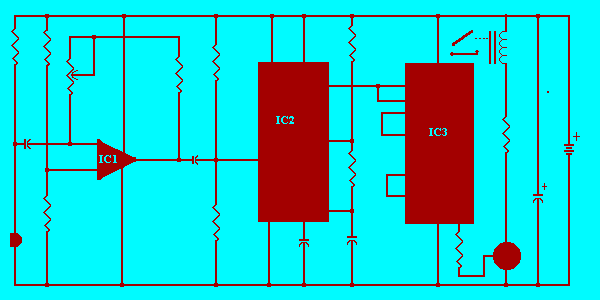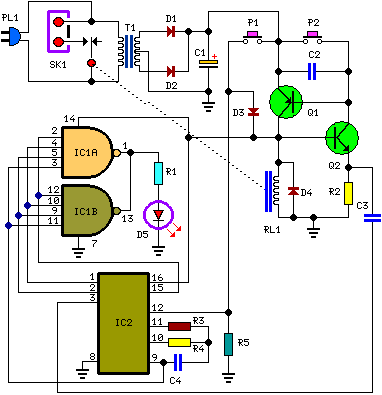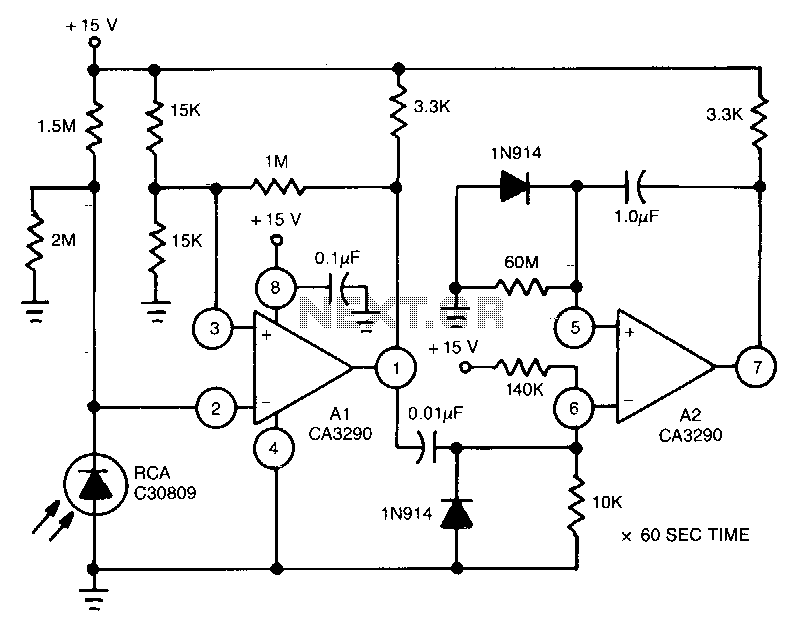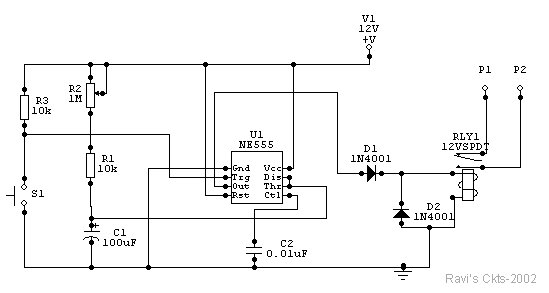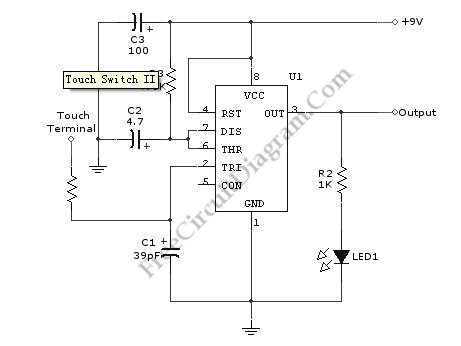
accurate reaction timer
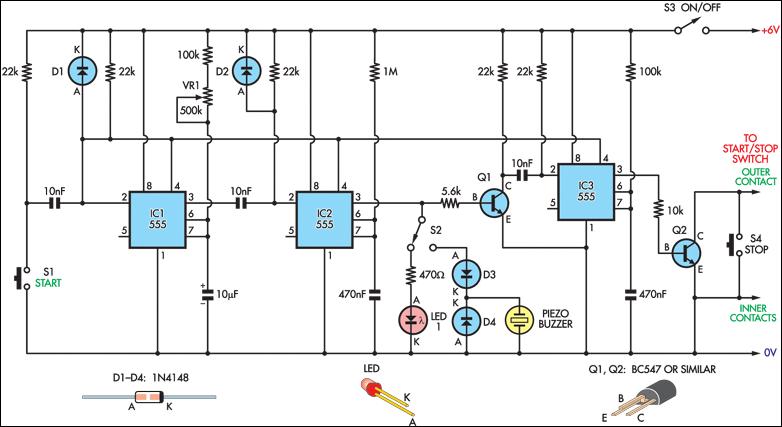
Integrate an inexpensive stopwatch into this circuit to create an accurate reaction timer. The circuit is connected in parallel with the start/stop button of the watch through a 2.5mm socket, which fits securely in one corner of the casing. The tester resets the stopwatch and activates the reaction timer's power switch (S3). The subject positions their fingers near the "STOP" push-button switch (S4). The tester then discreetly sets a delay time using VR1 and chooses either the LED or buzzer alarm via S2. To commence the sequence, the tester presses the "START" switch (S1). This action triggers 555 timer IC1, configured in monostable mode. Its output (pin 3) remains high for a duration of 2-12 seconds, as determined by the setting of VR1. Once this delay concludes, pin 3 goes low, activating IC2, another 555 timer in monostable mode. The output from IC2 (pin 3) energizes the alarm (buzzer or LED) for approximately 0.5 seconds. Following an inversion by Q1, it also triggers IC3, a third 555 monostable timer. The positive pulse from IC3 activates Q2, which briefly closes the start/stop switch circuit in the watch, causing the watch to begin counting. The subject then reacts to the alarm and presses the "STOP" button (S4), halting the stopwatch. The reaction time can be recorded with an accuracy of 1/100th of a second. Comparative reaction times can be assessed under various conditions, such as when the subject is rested or fatigued, silent or conversing, before or after a night out, or while using a mobile phone. For enhanced realism, dummy accelerator and brake pedals can be set up, with the brake switch serving as the stop contact. This setup can also be utilized in social settings to test individuals as they arrive and after they have been "steadying their nerves" at the bar.
The circuit design incorporates several key components to ensure accurate timing and functionality. The 555 timer ICs are critical in managing the timing sequences necessary for the reaction timer. The first 555 timer (IC1) is configured in monostable mode to generate a delay, the duration of which can be adjusted by the variable resistor (VR1). This flexibility allows the tester to customize the timing for different test scenarios.
The second 555 timer (IC2) serves as a trigger for the alarm system, providing auditory or visual feedback to the subject. The choice between the buzzer and LED alarm (controlled by switch S2) allows for adaptability depending on the testing environment. The brief activation period of 0.5 seconds ensures that the subject has sufficient time to respond without the alarm being overly intrusive.
The third 555 timer (IC3) is crucial for integrating the stopwatch functionality. It generates a pulse that briefly activates the Q2 transistor, which effectively simulates a press on the start/stop switch of the watch. This clever integration allows the watch to start counting automatically in response to the alarm, ensuring that the reaction time is accurately recorded.
The inclusion of the Q1 and Q2 transistors serves to isolate the 555 timer outputs from the watch circuit, preventing any potential damage from voltage spikes while maintaining reliable operation. The entire setup is designed to be user-friendly, allowing testers to easily initiate and monitor the reaction tests.
Overall, this reaction timer circuit is a versatile and effective tool for measuring human reflexes under various conditions, making it suitable for both casual testing and more structured experimental settings.Add a cheap stopwatch to this circuit to produce an accurate reaction timer. The circuit is wired in parallel with the start/stop button in the watch via a 2. 5mm socket, which fits snugly in one corner of the casing. The person conducting the test (the "tester") resets the stopwatch and turns on the reaction timer`s power switch (S3). The person b eing tested (the "subject") places his or her fingers near the "STOP" push-button switch (S4). Next, the tester covertly sets a delay time with VR1 and selects either the LED or buzzer alarm via S2. To initiate the sequence, the tester then presses the "START" switch (S1). This triggers 555 timer IC1, which is wired as a monostable. Its output (pin 3) goes high for 2-12 seconds as determined by the setting of VR1. At the end of this delay pin 3 goes low and triggers IC2, another 555 timer in monostable mode. The output from IC2 (pin 3) activates the alarm (buzzer or LED) for about 0. 5s. After inversion by Q1, it also triggers IC3, another 555 monostable. The positive pulse from IC3 turns on Q2, briefly closing the start/stop switch circuit in the watch. The watch starts to count up. After a short period, the subject reacts to the alarm and pushes the "STOP" button (S4), freezing the stopwatch.
The reaction time can then be read off with 1/100th of a second accuracy. Comparative reaction times could be measured when a subject is: rested or tired, silent or talking, before or after a night out, using a mobile phone, etc. For motoring realism, rig up dummy accelerator and brake pedals, with the brake switch making the stop contact.
Or take it to your club and test people as they enter and after they`ve been "steadying their nerves" at the bar. 🔗 External reference
The circuit design incorporates several key components to ensure accurate timing and functionality. The 555 timer ICs are critical in managing the timing sequences necessary for the reaction timer. The first 555 timer (IC1) is configured in monostable mode to generate a delay, the duration of which can be adjusted by the variable resistor (VR1). This flexibility allows the tester to customize the timing for different test scenarios.
The second 555 timer (IC2) serves as a trigger for the alarm system, providing auditory or visual feedback to the subject. The choice between the buzzer and LED alarm (controlled by switch S2) allows for adaptability depending on the testing environment. The brief activation period of 0.5 seconds ensures that the subject has sufficient time to respond without the alarm being overly intrusive.
The third 555 timer (IC3) is crucial for integrating the stopwatch functionality. It generates a pulse that briefly activates the Q2 transistor, which effectively simulates a press on the start/stop switch of the watch. This clever integration allows the watch to start counting automatically in response to the alarm, ensuring that the reaction time is accurately recorded.
The inclusion of the Q1 and Q2 transistors serves to isolate the 555 timer outputs from the watch circuit, preventing any potential damage from voltage spikes while maintaining reliable operation. The entire setup is designed to be user-friendly, allowing testers to easily initiate and monitor the reaction tests.
Overall, this reaction timer circuit is a versatile and effective tool for measuring human reflexes under various conditions, making it suitable for both casual testing and more structured experimental settings.Add a cheap stopwatch to this circuit to produce an accurate reaction timer. The circuit is wired in parallel with the start/stop button in the watch via a 2. 5mm socket, which fits snugly in one corner of the casing. The person conducting the test (the "tester") resets the stopwatch and turns on the reaction timer`s power switch (S3). The person b eing tested (the "subject") places his or her fingers near the "STOP" push-button switch (S4). Next, the tester covertly sets a delay time with VR1 and selects either the LED or buzzer alarm via S2. To initiate the sequence, the tester then presses the "START" switch (S1). This triggers 555 timer IC1, which is wired as a monostable. Its output (pin 3) goes high for 2-12 seconds as determined by the setting of VR1. At the end of this delay pin 3 goes low and triggers IC2, another 555 timer in monostable mode. The output from IC2 (pin 3) activates the alarm (buzzer or LED) for about 0. 5s. After inversion by Q1, it also triggers IC3, another 555 monostable. The positive pulse from IC3 turns on Q2, briefly closing the start/stop switch circuit in the watch. The watch starts to count up. After a short period, the subject reacts to the alarm and pushes the "STOP" button (S4), freezing the stopwatch.
The reaction time can then be read off with 1/100th of a second accuracy. Comparative reaction times could be measured when a subject is: rested or tired, silent or talking, before or after a night out, using a mobile phone, etc. For motoring realism, rig up dummy accelerator and brake pedals, with the brake switch making the stop contact.
Or take it to your club and test people as they enter and after they`ve been "steadying their nerves" at the bar. 🔗 External reference
